
Skinks are lizards belonging to the family Scincidae, a family in the infraorder Scincomorpha. With more than 1,500 described species across 100 different taxonomic genera, the family Scincidae is one of the most diverse families of lizards. Skinks are characterized by their smaller legs in comparison to typical lizards and are found in different habitats except arctic and subarctic regions.

Amphiglossus is a genus of skinks, lizards in the family Scincidae.

Anomalopus is a genus of worm-skinks, smallish smooth-scaled burrowing lizards in the family Scincidae. The genus is endemic to the eastern half of Australia. The genus belongs to a clade in the Sphenomorphus group which contains such genera as Ctenotus and the close relatives Eulamprus and Gnypetoscincus.
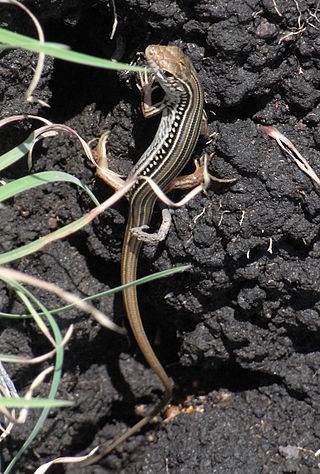
Ctenotus is a genus of skinks, lizards in the family Scincidae. The genus is endemic to Australia. The genus Ctenotus belongs to a clade in the Sphenomorphus group which contains such genera as Anomalopus and the close relatives Eulamprus and Gnypetoscincus.

The genus Eumeces comprises four African to Middle-Eastern skink species.

The prickly skink, or prickly forest skink, is a morphologically and genetically distinctive species of skink endemic to rainforests of the Wet Tropics of Queensland World Heritage Area, in north-eastern Australia. Unlike most small skinks, which have smooth scales, this species has rough, ridged and pointed scales. These keeled scales may be an adaptation to its high-rainfall habitat, to its microhabitat in rotting logs, or to camouflage it when moving through forest leaf-litter.

The earless skinks form the genus Hemiergis in the skink family Scincidae. All earless skinks are native to Australia. They are also called mulch skinks.
Janetaescincus is a genus of burrowing skinks in the family Scincidae. The genus is endemic to the Seychelles. There are two recognized species.
Nangura spinosa, the Nangur spiny skink or Nangur skink, is a lizard known from two patches of dry-rainforest in South East Queensland, Australia. It was formerly placed in the monotypic genus Nangura but was moved to Concinnia following the molecular phylogenetic studies of O'Connor & Moritz (2003) and Skinner and co-authors (2013). It was returned to Nangura in 2018. This species is known only from two localities; the type locality, now in Nangura National Park, and a much smaller isolated population in Oakview National Park and adjacent Oakview State Forest. The total distribution spans just 42 square kilometers, within which this species occupies less than 4 square kilometers, with an estimated population size of less than 200 individuals. It is threatened by invasive species including cats, pigs, dogs, foxes and cane toads, by the invasive plant species Lantana camara, which increases fire risk and changes forest structure, and in some sites by logging and road maintenance. Consequently, it is listed as critically endangered under the Australian Environment Protection and Biodiversity Conservation Act 1999 It resembles Gnypetoscincus queenslandiae in its spiny scales and like that species it is live bearing. Along with minor differences in scalation, the Nangur spiny skink differs from other Australian Sphenomorphid skinks in its karyotype of 2n=28 chromosomes, where most others have 2n=30. It is also unlike related species in that it lives in burrows, which occur in small colonies through the dry rainforest habitat. There is some indication of parental care in this species, with adults sharing burrows with juveniles.

The genus Sphenomorphus – vernacularly also known as the common skinks – currently serves as a "wastebin taxon" for numerous skinks. While most or all species presently placed here are probably rather close relatives, the genus as presently delimited is likely to be not monophyletic and is in need of review. Some species in this genus have been moved to Pinoyscincus.
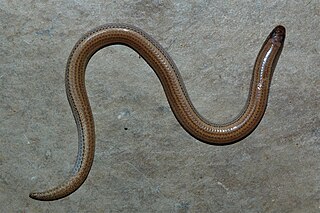
Typhlacontias is a genus of legless, burrowing skinks in the family Scincidae, a genus endemic to Sub-Saharan Africa. Its sister group is the clade consisting of the genera Feylinia and Melanoseps.
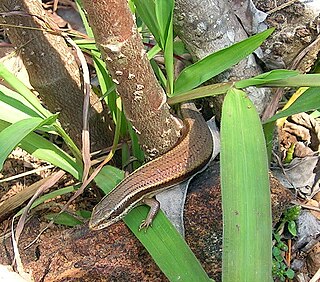
Lygosominae is the largest subfamily of skinks in the family Scincidae. The subfamily can be divided into a number of genus groups. If the rarely used taxonomic rank of infrafamily is employed, the genus groups would be designated as such, but such a move would require a formal description according to the ICZN standards.

Eulamprus quoyii, more commonly known as the eastern water skink, eastern water-skink, or golden water skink, is a viviparous species of diurnal skink. Eulamprus quoyii belongs to the family Scincidae and is considered a common garden animal in Australia. The skink is endemic to Australia and found only along the east coast of the country. It makes its home in creekside habitats along the east coast of Australia and in urban garden areas with high amounts of moisture. The species can be identified by the twin, long yellow stripes that run along its body from the top of the eye, as well as by several more specific character derived states. The pale yellow dorsolateral stripes are most likely where its common name, the golden water skink, is derived. Like other ectotherms, the skink can often be seen basking in the sun on rocky outcroppings in order to regulate its body temperature. Its diet mainly consists of both aquatic and terrestrial insects, tadpoles and small amounts of plant matter. The skink both hunts for food and scavenges when necessary and is considered an opportunistic feeder. It is prey to larger lizards, snakes, cats and birds and so will often be seen moving quickly into hiding when other organisms are present.

Saiphos equalis, commonly known as the yellow-bellied three-toed skink or simply three-toed skink, is a species of burrowing skink found in eastern Australia. It is the only species classified under the genus Saiphos.
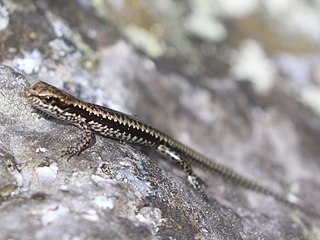
Concinnia is a genus of skinks in the subfamily Lygosominae.

Silvascincus is a genus of skinks, lizards in the family Scincidae. Both species in the genus are endemic to Australia. They were previously placed in the genus Eulamprus.

Sphenomorphinae is a large subfamily of skinks, lizards within the family Scincidae. The genera in this subfamily were previously found to belong to the Sphenomorphus group in the large subfamily Lygosominae.
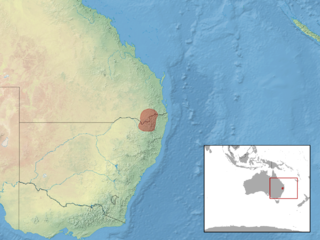
Silvascincus tryoni, the Border Ranges blue-spectacled skink or forest skink, is a species of lizard in the family Scincidae. It is endemic to the McPherson Range bordering New South Wales and Queensland, Australia.
Concinnia frerei, also known commonly as the stout bar-sided skink or the stout barsided skink, is a species of lizard in the family Scincidae. The species is endemic to Queensland in Australia.
Praeteropus is a genus of worm-skinks, smallish smooth-scaled burrowing lizards in the family Scincidae. The genus is endemic to the eastern half of Australia. The genus belongs to a clade in the Sphenomorphus group which contains such genera as Ctenotus and the close relatives Eulamprus and Gnypetoscincus.
















